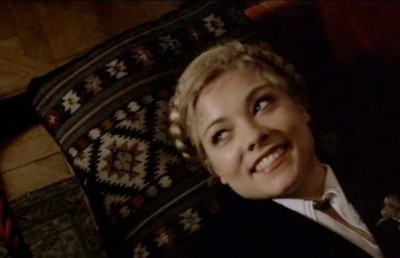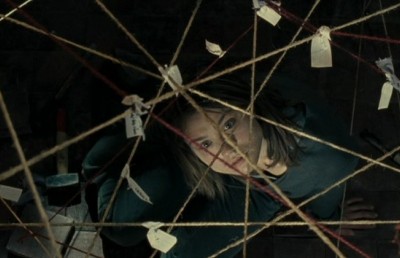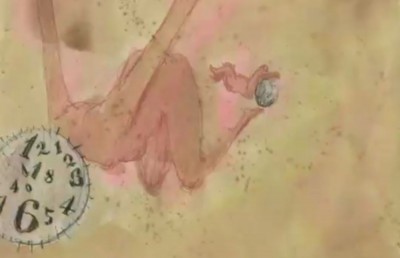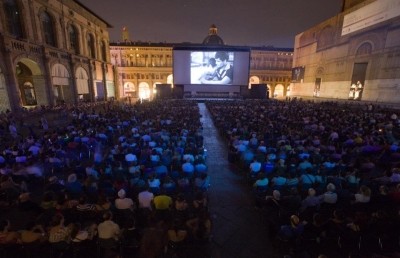The Disappearance (1977, Stuart Cooper): Melancholy and Murder
A Canadian Nugget From the 1970s from Twilight Time

The Disappearance (photo source, Twilight Time)
Spoiler Alert: Plot detail is revealed in this analysis.
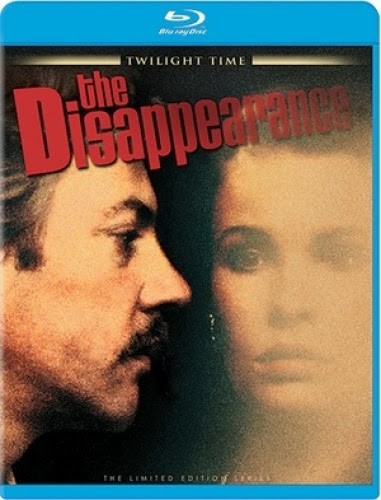
The Disappearance (photo source, Twilight Time)
Twilight Time (an arm of Screen Archives Entertainment) is a new (since 2011) independent DVD/BD/Audio label that specializes in classic, odd and forgotten films (and movie soundtracks). Unlike other labels that may have a more restricted focus, Twilight Time does not seem to have a set preference, outside of a preponderance of titles from the 1960s and 1970s, which gives them the freedom to release anything they see fit. Their titles usually come out in a release limit of 3000, which demonstrates their restricted appeal, but on the other hand, when releasing a more popular title, ensures a quick sell out and extravagant resale prices on EBay (Fright Night, Night Of The Living Dead, Christine). So hang on to your Twilight Titles. Response among cinephiles to Twilight Time releases has been generally positive, though with some reservations. For example, the noted 3000 release limit (which according to a Digital Bits article is a limit set by the licensing agreement they have with the studios), the high retail price, and the lack of special features (they usually provide only an isolated sound track as a feature). But the enthusiasm for Twilight Time from cinephiles is in their eclectic choice of releases and their uniformly good to excellent transfers. I have been purchasing their titles for a while now, including Blu Ray releases The Driver (1978, based on its parallels to Refn’s Drive), Robert Mulligan’s excellent supernatural period piece The Other, 1972, Walter Hill’s Hard Times, 1975, Jane Eyre (1944), and others. But I was particularly intrigued by a recent title that I had never heard of, a Canadian-British co-production about a contract killer whose wife goes missing, The Disappearance (1977, Stuart Cooper). The film is yet another example of interesting Canadian genre films that get too often overlooked by cultural guardians who state that Canada can’t make good genre films.
Before getting to the film itself, the varied people involved in the film and its production history (briefly explained by the director in a rare, for Twilight Time, special feature interview included on the Blu Ray) merit coverage on its own. The American born director Stuart Cooper began his film career as an actor, reaching a personal career high with The Dirty Dozen before realizing that directing was where his true interest lie. Prior to The Disappearance Cooper had directed two documentary shorts and two features (Little Malcom and His Struggle Against the Eunuchs, Overlord). The Disappearance was the first feature film produced by Canadian Garth Drabinsky under his independent film company Tiberius Productions. Drabinsky would go on to become one of the biggest players in the film distribution industry, making his mark with a successful run of films during the Canada Capital Cost Allowance period (The Silent Partner, The Changeling, Tribute) before challenging the Hollywood stranglehold on first run films in North America when his Cineplex chain of theatres purchased Odeon Theatres in 1984 (Douglas, p. 59).
The Disappearance is based on the novel by Derek Marlowe Echoes of Celandine, and the screenplay was written by British writer-director Paul Mayersberg, whose more illustrious writing credits include two films by master montagist Nicolas Roeg, The Man Who Fell to Earth (1976), and Eureka (1983), and Merry Christmas Mr. Lawrence (1983, Nagisa Oshima). The film has a sumptuous cast of Canadian and British players that includes Donald Sutherland as the lead contract killer Jay Mallory. In the interview we learn that Cooper, who had befriended both Sutherland and Lee Marvin when he acted alongside them in The Dirty Dozen, had initially wanted Marvin in the lead role. Marvin read and liked the script but turned it down because he claims to have told Cooper that he had already played that role (and indeed, Point Blank, casts a heavy shadow over on The Disappearance). So Sutherland agreed to do the role, but only after Cooper changed the ending of the script so that his character dies. Quebec born model turned actress Francine Racette stars as Mallory’s beautiful and enigmatic wife Celandine. Racette and Sutherland were in fact a married couple since 1972, and are still married with three children (one of them of course being actor Keifer Sutherland), which gives their several sex scenes and moments of intimacy an added element of naturalism. Racette’s other role of note was in Dario Argento’s Four Flies on Grey Velvet (1971). David Hemmings (who, like Racette, also starred in an Argento film, Deep Red, and also co-produced) has the role of Celandine’s first husband Edward. David Warner stars as Burbank, a contact for the criminal organisation that Mallory works for, referred to as the ‘Office’. A boyish looking John Hurt plays a similar role as the UK contact Atkinson. Christopher Plummer plays a small but important role as Roland Deverell, the head of the Office and the person responsible for his wife’s disappearance. And Virginia McKenna appears in one impeccably played scene with Mallory as Plummer’s love-lorn wife Catherine.
One other crew name that stuck out for me was the cinematographer, John Alcott, who filmed some of Stanley Kubrick’s greatest films, A Clockwork Orange, Barry Lyndon, and The Shining. Alcott also lensed Cooper’s previous film, the excellent realist World War 2 drama Overlord (1975). One of the greatest gains of watching the Twilight Time spanking new high definition transfer of the film is the subtle beauty of the lighting, with Alcott’s treatment of the wintry Montreal landscapes, the Montreal cityscapes at day and night and the varied and unique interior spaces both in Montreal and in the UK providing a thematic visual tapestry of moods and contrasts (luxurious waterside apartments, hospital, dockside, ship, baroque castle, etc.).
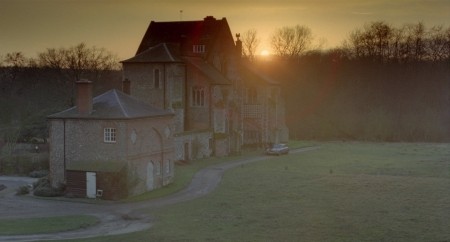
The Disappearance (photo source, Twilight Time)
According to the indispensable reference guide Canadian feature Film index: 1913-1985, the film was shot on 35mm in a six week period between January and February 1977 with locations in Montreal and Sorel Quebec and in Suffolk, England, and in Twickenham Film Studios in London, at a budget of $1,788,000 (shared 35% Canada, 65% UK). Of the budget $200,000 was provided by the Canadian Film Development Corporation (CFDC).
In dealing with the film itself the Blu Ray release offers a wealth of production intrigue in three different versions of the film that are represented:
Version 1: the original director’s cut which runs at 101 minutes and is healthily non-linear, influenced by the temporal experiments of earlier films such as Hiroshima Mon Amour (Alain Resnais, 1959), Don’t Look Now (Nicolas Roeg, 1973), and Point Blank (John Boorman, 1967).
Version 2: An unauthorized (by director Stuart Cooper) shortened, re-edited version that runs 81 minutes and attempts to put the narrative into a more coherent order by reducing the complexity of the narrative by coding the instances of non-linearity as flashbacks; and reducing their frequency and length.
Version 3: A third version that runs at 91 minutes but maintains the jumbled time frame and comes across as a leaner and more abstract version of the original.
From this point on these three versions will be referred to as V1, V2 and V3. According to the Canadian feature Film index: 1913-1985, although the film was shot in 1977 (and played at the 1977 San Sebastian Film Festival) it was only released theatrically in London, UK in 1981 and in Edmonton, Canada in 1982, and Toronto, Canada in 1983. For the delayed theatrical V2 release the film was re-edited by famed ‘film doctor’ Fima Noveck to its 81 minute length. Along with the re-edit, the Ravel music and original low key score by Robert Farnon was replaced by a new more ‘thriller’ friendly electronic music score composed by Craig Hundley. Based on this information we can surmise that the only time Cooper’s original 101 minute edit was screened theatrically was at the San Sebastian festival in 1977, since the official subsequent delayed theatrical release was V2. But what is intriguing is this bastard V3, which has surfaced specifically for this Twilight Time Blu Ray release. In the Blu Ray interview with Cooper he approves of the V3 version, but has no idea when it was done or who supervised it (on the Blu Ray liner notes by Julie Kirgo, Cooper suggests that it may have been producer/actor David Hemmings). It is impossible to do a fair and honest comparison of the three versions because of the quality discrepancy. V3 gets the full high definition transfer and is properly framed at 16 by 9, while the original director’s cut (V1) is a flat, full frame standard definition transfer. The 81 minute V3 appears in a 15 minute extract of the opening in the same dull, flat transfer, although a complete V3 is also available on YouTube. In the interview included on the Blu Ray Cooper says that the 81 minute version is “a disaster,” and said that much to the producers when they screened it for him; and all it takes is watching the 15 minute extract to comply with his opinion. Fima Noveck may have earned his reputation as a film doctor salvaging European films for less sophisticated tastes, but his cut ruins The Disappearance. Everything the film gains comes in the details, not the shop worn plot about a tired contract killer having a moment of existential crisis, triggered by the disappearance of his wife. Placing the scenes between him and his wife and the crime moments side by side in a more coherent manner only serves to underscore how bland they are. Setting them off against each other temporally in V1 and V3 adds to the mystery of the disappearance and the nuance of character psychology. Does Celandine leave Mallory for another man? Or does she leave just to get away from Mallory, who is after-all a killer? Is Celandine mentally unbalanced, as suggested in some of the dialogue exchanges between them? Or has she been kidnapped or murdered by the Office or by someone out for revenge? Is Celandine, who placed the hit on Deverell, also responsible for the death of her husband at the end? When Mallory goes out for breakfast food and is ambushed by two gun shots, the scene cuts to a close-up of Celandine responding to the gunshot. Her expression is such that we do not know if she is shocked, surprised, or merely reacting to what she expected. All of these possibilities are removed by the more linear structure of V2.
Whereas in V1 and V3 Celandine is already missing when Mallory comes home, in V2 Celandine is home when Mallory returns from his contract hit and they enjoy a night in. When Celandine reminisces about when they first met we get the only flashback featuring them, to the night when she and her first husband Edward (David Hemmings) appear at the same evening party with Mallory, who is there stalking a “shy” (the euphemism used by the Office to describe a victim). The scene then cuts back to the present, in an eerie scene where the sleeping Mallory has a nightmare where he envisions being shot dead in his sleep by his double. She wakes up next to him and they talk, with the conversation ending when Celandine threatens Mallory, “One day I’ll leave you.” The scene cuts to the next morning, where the original opening of Mallory arriving to an empty apartment is sutured into the narrative, largely on the coherency of Celandine’s threat of leaving. Unlike the more enigmatic disappearance of V1 & V3, here we are asked to believe that Celandine owned up to her threat to leave and disappeared over night. She does not appear again until the end of the film.
In a review of the film in the (sadly) now defunct Canadian film trade paper, Cinema Canada, reviewer J. Paul Costibile is aware of the two different versions of the film. The posted credits at the end of the review have two editor credits, Eric Boyd-Perkins for the ‘original version’ and Fima Noveck for the “revised version” (in the on-screen credits Noveck also gets a “Creative Supervisor” credit). Costibile writes as if he has somehow seen both versions, noting “The dark narrative, fractured by numerous flashbacks, calls to mind the work of Nicolas Roeg, and not without reason. In addition to the presence of Donald Sutherland in the lead role —he appeared in Roeg’s Don’t Look Now — the script is by Paul Mayersberg, who also wrote for Roeg The Man Who Fell To Earth” (p. 30). The only scene in V2 which uses flashbacks in a “Roegian” sense is the early scene between Mallory and Burbank, which has two insert flashbacks to Mallory shooting Cheevers/James, and one insert flashback to him kissing his wife’s back in bed. Hence I would surmise that reviewer Costibile may have somehow seen the more collage-like V1, when he acknowledges and lays the blame for much of the film’s failure at the editorial revisions: “Moreover, in re-editing the film, Fima Noveck…has cut the flashbacks to such a degree that they have little impact and give none of the psychological insights into the characters that is the raison d’etre for the device in the first place” (p. 30). The other change in V2, an electronic music score that replaces the original music, strips the film of its mood shifts and tonal ambiguities.
Having watched all three versions, my preference is for V3, the 91 minute cut; again, the difference between watching it in high definition, with the colors popping out of the screen and the wonderful detail in the natural scenes of water, sunsets, and snow may unfairly bias the 91 minute version; but the additional scenes of plot in V1 don’t seem to add much to the over-all impact, while the abrupt opening of the 91 minute version adds to the mystery of Celandine’s disappearance. For instance, the original version (V1) opens with a brief intimate scene set at night time of Mallory and Celandine in their loft apartment, with Celandine playing a piece on the piano that will become a musical motif. Coming at the beginning this sets this moment as the present. This then cuts to a wintry day time setting and Mallory performing his first contract on a man in a docked ship. The temporal relationship between this and the opening scene is unclear. He stops at a phone booth on his way home from the contract kill to call home and we hear his wife’s voice on the other end of the line. He then returns home to find his wife missing. As he walks around the apartment we get the first of a series of flashbacks between him and Celandine.
V2 begins with Mallory performing the hit and stopping at the pay phone to call Celandine to tell her he is on his way home. As in V1 we hear Celandine’s voice coming through the phone. He then arrives at home to spent the evening with Celandine. Contrarily, V3 opens straight on a wintry country road with Mallory’s car stopping at the phone booth and Mallory calling home. Only now the phone rings on without an answer on the other end and he hangs up and drives back home to find his wife missing. Oddly one of the first things we hear as he arrives home is the sound of a phone detached from its cradle. Not establishing the wife’s presence, which the other two versions do by the sound of her voice on the phone (and seeing her at the piano in the opening of V1) makes her disappearance even more enigmatic, to the point where we may even doubt whether she is still alive, and consider that Mallory may be keeping her memory alive through the subjective flashbacks.
In V3 the contract hit we see at the beginning in V1 and V2 in a ship’s hull is intercut later at the ten minute mark, triggered by the arrival of his contact Burbank (David Warner) and his words, “We were very pleased with the man on the boat.” We learn this first victim was a fellow assassin who became “unreliable.” In another minor difference, in V1 this first victim speaks a few dying words to Mallory just before he is shot a second time (“You shouldn’t have done that”) while he remains silent in V2 and V3.
The film in its V1 and V3 is obviously influenced by modernist films that challenged conventional linear narrative, such as Hiroshima, Mon Amour,(Alain Resnais, 1959) and Point Blank (John Boorman, 1967), including a direct homage to the latter in the shot where Mallory is framed at a low angle and walks quickly along a high key corridor, with the camera tracking his steps back, Performance (Donald Cammell, Nicolas Roeg, 1970) and Don’t Look Now (Nicolas Roeg, 1973), right down to a love scene with bodies entwined, but The Disappearance can also be seen as a possible influence on two films by Steve Soderbergh, The Limey (1999) and Solaris (2002) (quite likely a indirect influence, since it is hard to imagine that Soderbergh saw The Disappearance before making these two films).
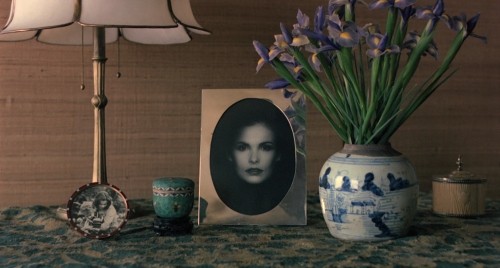
The Disappearance (photo source, Twilight Time)
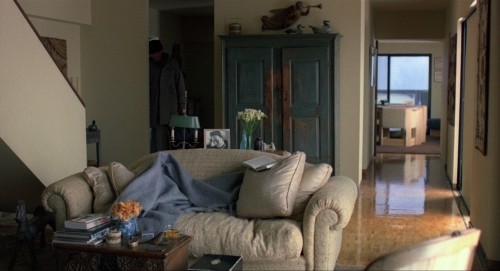
Opening The Disappearance (photo source, Twilight Time)

Ending The Disappearance (photo source, Twilight Time)
Although a crime melodrama about a contract killer becoming emotionally spent and experiencing a sort of existential crisis (which ties it to other crime films with similar existentialist anti-heroes, The Driver, The Thief, and Drive), thematically The Disappearance is about memory, in a Proustian sense, where events, objects in the present trigger past memory: a dress recalls his wedding day; a car crash invokes an accident with Celandine’s son; handling his gun triggers the moment when Celandine first found his gun in his coat pocket, etc.). In one of the flashback scenes between Mallory and Celandine they even play a memory game, where Celandine arranges objects on a tray that Mallory has to remember and call out.
Another subtle indicator of the memory theme is the proliferation (and narrative importance) of photographs and portrait paintings in the mise en scène. Photographs especially, are an indicator of a memory frozen in time. When Mallory returns home in the beginning we are introduced to Celandine through a glamorous photo of her on the grand piano (with a smaller photo to the left), with the camera accentuating the moment with a liquid like dolly back movement in which a reflection of the photo is also seen on the piano top. We hear the off-screen sound of a door opening and then cut to Mallory entering the living room, with a photograph of Mallory visible in the middle ground of the shot behind the sofa.
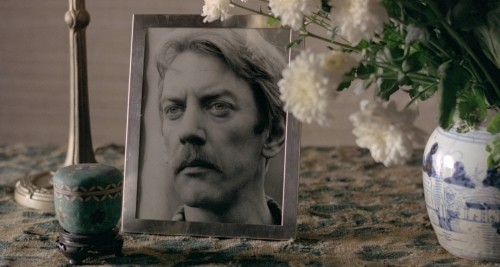
The Disappearance (photo source, Twilight Time)
The position of this photo will change in the final scene (to which I’ll return). As Mallory puts the phone back on the hook he glances up and looks off-screen, which cues a cut to his point-of-view shot of the photograph of Celandine on the piano. In these three shots Cooper establishes a link between presence/absence and the photographs: Mallory is seen in frame with his photograph, while Celandine remains absent from her image. This ‘homecoming’ scene is repeated with sublte variations in the final scene, with photographs again sourcing important meaning. A sense of déjà vu opens the scene with an almost identical shot of Mallory walking along the cement half-covered embankment (only the color of his coat changes).
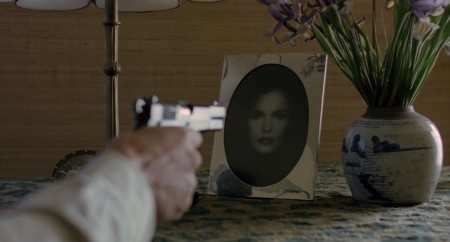
The Disappearance (photo source, Twilight Time)
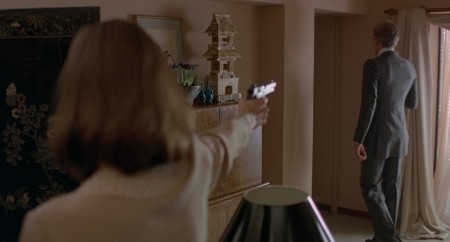
The Disappearance (photo source, Twilight Time)
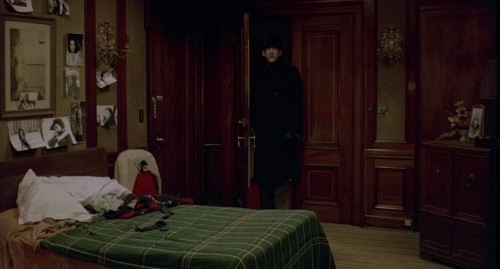
Edward’s Apartment (photo source, Twilight Time)
As he enters the apartment everything appears the same as the mirroring shot from the beginning, but the observant viewer will notice that Mallory’s photograph is no longer behind the sofa. Mallory notices this and looks off-screen cueing us to its new location: Mallory’s photo has replaced Celandine’s on the piano. For Mallory this switching of the photograph signals the presence of Celandine; he smiles, runs upstairs and finds Celandine waiting for him in the bathtub.
The photograph contains a possibly important plot clue in the scene that begins in the present with Mallory seated at the piano with gun in his hand and slowly pans his gun hand to the right and stops with the gun pointed directly at the photo of Celandine. This is counterpointed to a flashback where we see Celandine holding the gun at the exact same position in the frame but at Mallory: is this an oblique suggestion that Celandine will ultimately kill Mallory?
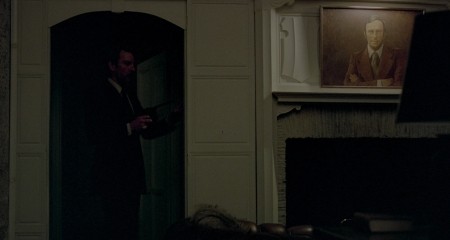
Deverell’s Portrait (photo source, Twilight Time)
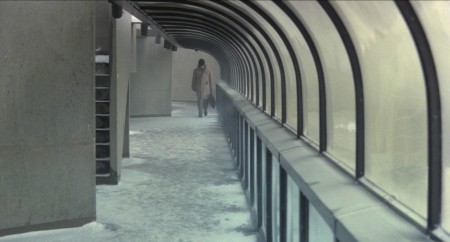
Returning Home in the Opening (photo source, Twilight Time)
Photographs (of Celandine, her dead son Dominic, Mallory, and her first husband Edward) are present elsewhere and everywhere in the apartment (on the bedroom night tables and dresser, for example). Mallory looks intently at photographs of Celandine in a glamour magazine. In the kitchen behind the seated Mallory we see a Modigliani-like painting of a woman who gives the impression of illness or frailty, perhaps a comment on Celandine (who is framed with the painting in the kitchen scene). In the flashback where they first meet at a luxurious dinner party, they first kiss in a room adorned wall to wall with classic oil paintings. One of the objects in the memory game Mallory and Celandine play is a postcard of a nude with one of Mallory’s bullets positioned, to quote Mallory, “on her bum”. (22”)
Photographs are not restricted to Mallory’s apartment. The ‘Office’ fronts as an advertising agency and the office is littered with glamour magazine covers featuring models. When Mallory visits Celandine’s first husband Edward we see the wall above his bed filled with photos of Celandine. And Deverell’s home contains a large self-portrait.
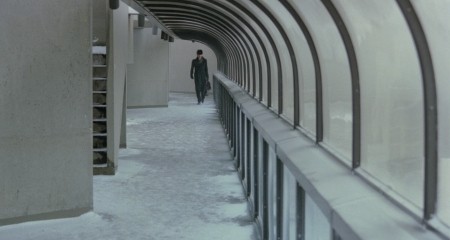
Returning Home in the Ending (photo source, Twilight Time)
This large self-portrait appears toward the end in the scene where Mallory breaks into Deverell’s home to kill him, hanging on the wall above the staircase. Deverell, the man who is having an affair with his wife and whose desire it is to steal Celandine from him, triggers a memory where Celandine and Mallory are on the bed together and they have an exchange about infidelity: Celandine: “If you were having an affair would you tell me about it? Mallory replies, “No.”
Deverell, played with menace and authority by Christopher Plummer, is a sort of alter ego/double for Mallory, and this theme of the double is introduced earlier in an eerie moment where Mallory is being threatened in his sleep by a gun bearing intruder, who ends up being Mallory’s dream double. The shot of Deverell’s portrait on the wall, followed by Mallory acknowledging this portrait, and then his confrontation with Deverell only increases this theme of the double (which is also invoked by Celandine/Catherine, Burbank/Jefferies, and Burbank/Atkinson).
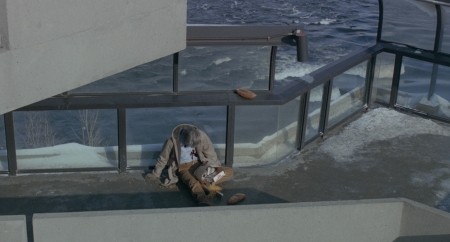
Mallory’s mysterious death (photo source, Twilight Time)
Director Cooper never plays easy or conventional with his use of this common trope, the flashback. In one scene we see Mallory lying in bed flipping through a glamour magazine featuring a spread of his wife. He looks intently at a page featuring his wife (which leads us to think she is absent) and then we hear his wife’s voice off-screen speaking to him. We assume the scene is in the present and the voice a subjective internal voice-over, but then the shot cuts to a long shot of a silhouetted Celandine standing nude outside the bathroom, establishing this as a flashback. Celandine says, “I want you. Right from the first, that’s what I wanted, you.” These words, “right from the start” trigger a flashback within a flashback, or memory within a memory to when they first met. The camera frames cigarette smoke and then pans right and dissolves to a dinner party attended by Celandine and her first husband Edward, to which Mallory just happened to be there stalking his “shy” (victim). In V3 nearly every scene has a temporal shift between present and past/memory, some easily accessed, others more complex and ambiguous, cementing the film as a serious treatment of the theme of memory. The final scene where Mallory returns home has echoes of the opening return home. For example, the walk along the half-covered embankment and identical insert shots of his empty apartment. Are the repeated empty insert shots a flashback of the opening scene, or a flash-forward of when he will arrive? The penultimate line we hear Mallory say to Celandine in this final scene where he returns home to find his wife there waiting for him points to this direction: “Death is a country without memory…dead people cannot remember a god damned thing.”
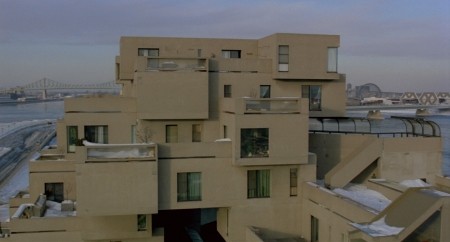
Modern Montreal (photo source, Twilight Time)
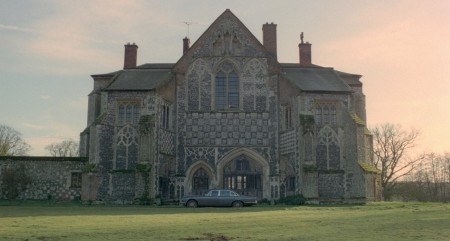
Classical London (photo source, Twilight Time)
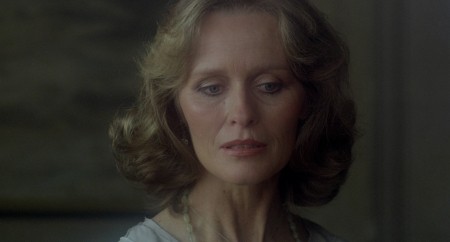
Catherine….(photo source, Twilight Time)
Complementing the intriguing theme of memory is the outstanding cinematography by John Alcott and great use of locations (Moshe Safdie’s Habitat 67 building complex designed for the Montreal Expo 67 World Fair, the docks, the Montreal cityscape, the St. Lawrence River, the wintry images of the unmistakable United States of America Pavilion at the Fair, since known as the biosphere (preceding Robert Altman’s use of the same setting in his 1979 science fiction film Quintet), etc.. Alcott’s lighting takes to the fore in the scene where Mallory stalks Deverell in his night time home, and then the greenhouse, with inky blacks and noirish chiaroscuro contrasting the snow set streets and glossier lit interiors. Or in the beautiful sunset when Mallory leaves his visit with Catherine. The imagery, light and architecture of Montreal and Suffolk are contrasted to each other, but paralleled in other respects. For example, each location features a phone booth, bored house wives married to killers, who are similar in appearance if disparate in age (Celandine and Catherine), two ‘contacts’, two ‘shy’ kills, two accident scenes involving a boy, remarkable architectural spaces, etc..
Contrasting & Paralleling Montreal & London:
{media_18}
{media_19}
{media_22}
{media_23}
Twilight Times’ Blu Ray of The Disappearance is one of the most pleasantly surprising releases of 2013, proving once again that there is much to discover about a cultural heritage, film, which is threatening to give way to another manifestation of cinema, digital. In his interview Cooper claims that this film, made the way it was, with its challenging narrative structure, bleak and unresolved ending (we never know who kills Mallory), and somewhat opaque characters, could never have been made in the US. I would add that much of its visual beauty, lensed by master cinematographer John Alcott on glorious 35mm film, will also not be possible with the new medium of digital cinema, at least not in quite the same way (digital can be beautiful in an entirely different way). With the previous criticism of the label noted in the introduction aside, this release exemplifies what makes Twilight Time a special label: bringing to light forgotten or undiscovered nuggets from our cinematic past. In this case, specifically, a Canadian film past (realizing that it was a co-production with the UK)) which continues to surprise where orthodoxy often pigeonholes Canadian cinema as dull, realist or parochial.
Bibliography
Costabile, Paul J. “Stuart Copper’s The Disappearance,” Cinema Canada, #98, July-August 1983, p. 30-31
Douglas, David. Guide to the Cinema(s) of Canada, Peter Harry Rist, ed., 2001, p. 59-60
Jahnke, Adam, Dr. “The Trouble With Twilight Time,” August 5, 2013.
Turner, John D. Canadian Feature Film Index: 1913-1985, 1987, p. 239-240.



